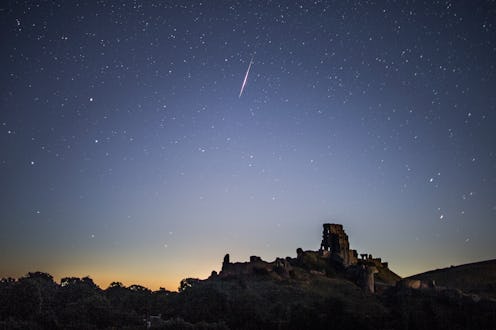Life
Here's When To Catch The Next Big Meteor Shower

If you caught the Eta Aquariids lighting up the skies at their peak on May 6, you may already be wondering when the next meteor shower will take place. Technically, the Eta Aquariids are still burning their way through the atmosphere, so you still have time to catch the shower as it winds down through May 20. After that, though, you'll have to wait until nearly August for the next major meteor shower, the southern Delta Aquariids.
Like most showers, the Delta Aquariids are named for their position in the sky. The meteors look like they originate from the Delta star in the Aquarius constellation, and they're best viewed from the southern hemisphere. (The ongoing Eta Aquariids radiate from a star in the same constellation — does that make the two showers celestial siblings?) The Delta Aquariids are unique in that they don't have much of a visible peak, staying relatively steady throughout late July and early August. At its fastest rate, somewhere between 15 and 20 medium-speed meteors are expected to shoot across the night sky.
However, the formal peak is expected to be between July 27 and 30, so if you live in the southern hemisphere, mark your calendars for those nights — or rather, the early mornings. According to EarthSky.org, the best time to view the meteor shower is just before dawn, when moonlight won't wash out the light from the shooting stars.
If you live in the northern hemisphere, your chances of catching a good view of the Delta Aquariids are slim. On the other hand, you won't have to wait long for a different show. The spectacular Perseid meteor shower, which can reach up to 90 meteors an hour, is predicted to peak on August 12 and 13. According to EarthSky.org, this well-known shower tends to strengthen in number over the course of the night, with the most meteors visible just before dawn.
Unfortunately, it might be more difficult than usual to catch sight of the Perseids this year. As Sky and Telescope notes, the moon will be just a few days past full at the Perseids' peak, so its light will probably compete with the meteors'.
In case you're wondering, meteor showers occur when Earth passes through the debris left in the wake of comets on their journey around the galaxy. Basically, comets are slowly disintegrating in the heat of the Sun, leaving a trail of rocky particles behind. Earth's orbit sometimes takes it through these leftovers. The debris burns up as it enters our atmosphere, creating an annual shower of shooting stars. Are you feeling like a tiny speck of life in a vast universe yet?